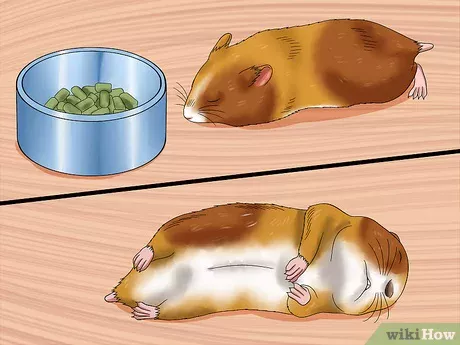If a hamster bites you and it bleeds, clean the wound and apply an antiseptic. Then seek medical attention to prevent infection and ensure proper healing.
Hamster bites can be painful and potentially lead to infection. While these creatures are generally gentle, they may bite in response to fear or feeling threatened. It’s essential to address the wound promptly to avoid complications. Additionally, it’s important to understand the reasons behind the bite to prevent future incidents.
We will delve into the potential risks of hamster bites, proper wound care, and tips for preventing bites. Understanding these aspects will ensure that you can safely and enjoyably interact with your pet hamster.
Understanding Hamster Bites
There may be instances when your furry friend, the hamster, unintentionally bites you. Understanding hamster bites and the potential risks involved is crucial in ensuring the well-being of both you and your pet. In this article, we will explore common reasons for hamster bites and the risk of infection that can arise from such bites.
Common Reasons For Hamster Bites
Hamsters are generally friendly and docile creatures, but they can become aggressive or defensive in certain situations. Understanding the common reasons behind hamster bites can help us minimize the chances of getting bitten.
1. Fear and Stress: Hamsters are naturally prey animals, so they can feel threatened easily. If a hamster feels frightened or stressed, it may resort to biting as a defensive mechanism.
2. Mishandling: Improper handling, such as squeezing or restraining the hamster too tightly, can cause discomfort or pain, leading to a bite.
3. Territorial Behavior: Hamsters are territorial animals, and they can become possessive of their living spaces. If they perceive someone or something as invading their territory, they might bite.
4. Pain or Illness: A hamster experiencing pain or illness may react defensively by biting. This can occur if the hamster has an injury or an underlying health condition.
Risk Of Infection From Hamster Bites
While hamster bites can be painful, the risk of infection is another concern to be aware of. The bacteria present in a hamster’s mouth can potentially enter the wound, leading to an infection. It is important to take appropriate measures to prevent infection and ensure proper wound care.
1. Clean the Wound: If a hamster bite breaks the skin and causes bleeding, it is important to clean the wound thoroughly. Use mild soap and warm water to cleanse the area, gently removing any dirt or debris.
2. Apply an Antiseptic: After cleaning the wound, apply an antiseptic solution or ointment to prevent infection. This can help kill any bacteria that may have entered the wound.
3. Monitor for Signs of Infection: Keep a close eye on the wound for any signs of infection, such as redness, increased pain, swelling, or discharge. If any of these symptoms appear, it is advisable to seek medical attention.
4. Consider Tetanus Shot: If the hamster bite is deep or you haven’t received a tetanus shot in the last five years, it may be wise to consult a healthcare professional regarding the need for a tetanus booster shot.
By understanding the common reasons for hamster bites and taking appropriate precautions, we can minimize the likelihood of getting bitten and reduce the risk of infection. Remember, a healthy and happy hamster is less likely to resort to biting, so providing a suitable environment and handling them with care are essential for fostering a trusting relationship with your furry companion.
:strip_icc()/a0047-000145-56a2bce25f9b58b7d0cdf7cf.jpg)
Credit: www.thesprucepets.com
Dealing With A Bleeding Hamster Bite
If a hamster bite causes bleeding, wash the wound with soap and water, then apply pressure to stop the bleeding. Seek medical advice if necessary. Keep the bite clean and monitor for signs of infection to ensure proper healing.
Dealing with a Bleeding Hamster Bite Immediate First Aid Steps If a hamster bites you and it results in bleeding, it’s essential to act quickly to prevent infection and promote healing. Follow these immediate first aid steps when dealing with a bleeding hamster bite: 1. Clean the Bite Rinse the bite under running water to remove any dirt and bacteria. Gently wash the area with mild soap and pat it dry with a clean cloth. 2. Apply Pressure Use a sterile gauze or clean cloth to apply gentle pressure to the bite. This can help stop the bleeding and reduce the risk of further injury. 3. Apply Antiseptic Apply a small amount of antiseptic ointment to the bite to prevent infection. Be sure to use a product that is safe for use on small wounds, and consult a medical professional if you are uncertain. 4. Cover the Wound Once the bleeding has stopped, cover the wound with a bandage or adhesive strip to protect it from further contamination. When to Seek Medical Help While minor hamster bites may be effectively treated with at-home first aid, there are instances when seeking medical help is necessary. Consider these guidelines for when to seek medical assistance for a bleeding hamster bite: 1. Excessive Bleeding If the bleeding is severe or difficult to control, seek medical help immediately. 2. Signs of Infection Watch for symptoms of infection, such as increased pain, redness, swelling, or discharge from the wound. If these signs develop, consult a healthcare professional promptly. 3. Abnormal Healing If the wound does not show signs of improvement within a few days, or if you experience ongoing pain or discomfort, it’s critical to seek medical attention. Remember, while taking immediate first aid steps can help address a bleeding hamster bite, it’s important to be aware of when professional medical care may be necessary. By following these guidelines, you can effectively navigate the aftermath of a hamster bite and ensure proper care for the injury.Preventing Hamster Bites
Understanding hamster behavior and proper handling techniques are crucial to preventing hamster bites that can potentially cause bleeding.
Understanding Hamster Behavior
Hamsters are small animals with a natural instinct to defend themselves. When they feel threatened or scared, they may resort to biting as a form of self-defense. It’s essential to realize that hamsters may not bite out of aggression, but rather as a reaction to feeling unsafe. Learning to recognize their signs of stress or fear can help in avoiding potential bites.
Hamsters are nocturnal creatures, so they are more active during the night. Disturbing them during their rest period can make them more likely to bite. Understanding and respecting their natural rhythms can reduce the risk of bites.
Proper Handling Techniques
When handling a hamster, it’s important to approach them gently and avoid sudden movements that may startle them. Always ensure your hands are clean, and avoid handling the hamster if you have strong scents on your hands as hamsters have a keen sense of smell.
- Approach the hamster from the side, allowing them to see and sniff your hand before attempting to pick them up.
- Support the hamster by cupping your hands beneath them to provide a secure and comfortable hold.
Proper handling techniques not only minimize the risk of bites but also ensure that the hamster feels safe and secure in your hands, fostering a positive interaction. By practicing gentle and respectful handling, you can significantly reduce the likelihood of being bitten and causing bleeding.
Creating A Safe Environment For Your Hamster
Creating a Safe Environment for Your Hamster
Hamsters are cute and fascinating little creatures that can make wonderful pets. However, it’s important to create a safe environment for your furry friend to ensure their well-being and happiness. Providing a suitable cage and engaging enrichment activities are crucial aspects of hamster care. Let’s explore these in detail below.
Assessing Cage Conditions
When it comes to hamster cages, size and structure matter. A cramped cage can lead to stress, while one with large gaps between bars may pose a safety hazard. It is recommended to choose a cage specifically designed for hamsters, with bar spacing no wider than half an inch. Ensuring proper ventilation is also essential for your hamster’s respiratory health. Suggestions: – Select a cage with ample space for your hamster to move around, exercise, and explore. – Provide a solid floor or a layer of bedding to prevent any injuries to your hamster’s feet. – Avoid cages with wire mesh floors, as they can cause pain and discomfort to your furry friend.Enrichment Activities For Your Hamster
Hamsters are active creatures that love to explore and engage in stimulating activities. Offering a variety of enrichment opportunities can keep them mentally and physically stimulated, preventing boredom and behavioral issues. Suggestions: – Provide tunnels, hideouts, and climbing structures to create an engaging habitat for your hamster. – Offer different textures and materials for them to dig, burrow, and nest in, such as shredded paper or hamster-safe bedding. – Rotate toys and add new ones regularly to keep your hamster’s interest piqued. In conclusion, by creating a safe environment and providing enriching activities, you can ensure the well-being and happiness of your hamster. A suitable cage and varied stimuli will not only improve their quality of life but also prevent potential issues such as biting or other undesirable behaviors. Remember, a happy and healthy hamster makes for a delightful and content pet!Seeking Professional Advice
If a hamster bites you and it bleeds, seeking professional advice is crucial to ensure proper treatment and prevent possible infections. Hamster bites can be risky, and getting prompt medical assistance is important for your own well-being.
Consulting A Veterinarian
If your hamster bites you and it begins to bleed, it’s crucial to consider seeking professional advice from a veterinarian.
Behavioral Training For Your Hamster
Implementing behavioral training for your hamster can help prevent biting incidents in the future.

Credit: www.reddit.com

Credit: www.wikihow.com
Frequently Asked Questions Of What Happens If A Hamster Bites You And It Bleeds
Why Do Hamsters Bite And What Causes Bleeding?
Hamsters may bite out of fear, stress, or feeling threatened. Bleeding can be caused by deep bites breaking the skin. It’s important to handle them gently and avoid sudden movements.
How To Handle A Bleeding Hamster Bite?
If your hamster bites and causes bleeding, gently clean the wound with water and apply pressure with a sterile gauze. Monitor for signs of infection and consult a veterinarian if needed.
Can A Hamster Bite Transmit Diseases To Humans?
Hamster bites can introduce bacteria into the bloodstream, increasing the risk of infection. It’s crucial to keep the wound clean, monitor for any signs of infection, and seek medical attention if necessary.
Conclusion
If a hamster bites you and it bleeds, it’s important to take immediate action to ensure proper care and prevent infection. Clean the wound gently, apply an antiseptic, and monitor for any signs of complications. Remember, while hamster bites are generally minor, it’s crucial to handle these situations responsibly and prioritize your health.
Stay informed and take necessary precautions to avoid similar incidents in the future.
- Friendship Fur-Ever: Unveiling The Secrets Of Friendly Hamsters - April 19, 2024
- Laugh Out Loud: Funny Hamster Moments That Will Brighten Your Day - April 19, 2024
- The Ultimate Guide To Good Hamster Keeping: Tips And Tricks For Happy Pets - April 19, 2024


